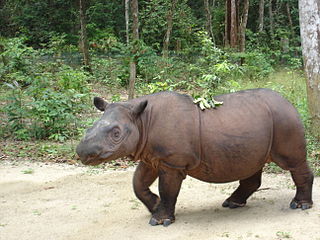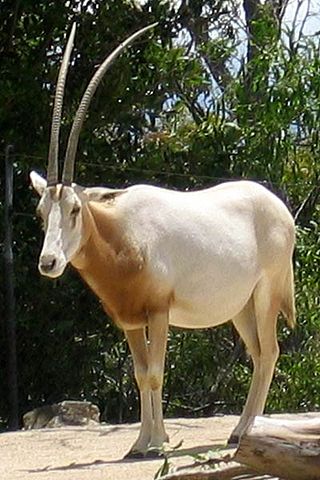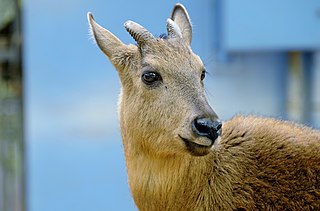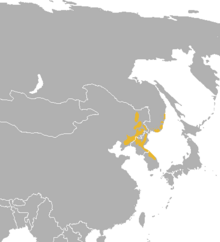
The bongo is a large, mostly nocturnal, forest-dwelling antelope, native to sub-Saharan Africa. Bongos are characterised by a striking reddish-brown coat, black and white markings, white-yellow stripes, and long slightly spiralled horns. It is the only tragelaphid in which both sexes have horns. Bongos have a complex social interaction and are found in African dense forest mosaics. They are the third-largest antelope in the world.

The clouded leopard, also called mainland clouded leopard, is a wild cat inhabiting dense forests from the foothills of the Himalayas through Northeast India and Bhutan to mainland Southeast Asia into South China. It was first described in 1821 on the basis of a skin of an individual from China. The clouded leopard has large dusky-grey blotches and irregular spots and stripes reminiscent of clouds. Its head-and-body length ranges from 68.6 to 108 cm with a 61 to 91 cm long tail. It uses its tail for balancing when moving in trees and is able to climb down vertical tree trunks head first. It rests in trees during the day and hunts by night on the forest floor.

Oryx is a genus consisting of four large antelope species called oryxes. Their pelage is pale with contrasting dark markings in the face and on the legs, and their long horns are almost straight. The exception is the scimitar oryx, which lacks dark markings on the legs, only has faint dark markings on the head, has an ochre neck, and has horns that are clearly decurved.

The Sumatran rhinoceros, also known as the Sumatran rhino, hairy rhinoceros or Asian two-horned rhinoceros, is a rare member of the family Rhinocerotidae and one of five extant species of rhinoceros; it is the only extant species of the genus Dicerorhinus. It is the smallest rhinoceros, although it is still a large mammal; it stands 112–145 cm (44–57 in) high at the shoulder, with a head-and-body length of 2.36–3.18 m and a tail of 35–70 cm (14–28 in). The weight is reported to range from 500–1,000 kg (1,100–2,200 lb), averaging 700–800 kg (1,540–1,760 lb). Like both African species, it has two horns; the larger is the nasal horn, typically 15–25 cm (5.9–9.8 in), while the other horn is typically a stub. A coat of reddish-brown hair covers most of the Sumatran rhino's body.

The Indian rhinoceros, also known as the greater one-horned rhinoceros, great Indian rhinoceros, or Indian rhino for short, is a rhinoceros species native to the Indian subcontinent. It is the second largest extant species of rhinoceros, with adult males weighing 2.07–2.2 tonnes and adult females 1.6 tonnes. The skin is thick and is grey-brown in colour with pinkish skin folds. They have a single horn on their snout that grows to a maximum of 57.2 cm (22.5 in). Their upper legs and shoulders are covered in wart-like bumps, and aside from the eyelashes, ear fringes and tail brush, Indian rhinoceroses are nearly hairless.

The kouprey, also known as the forest ox and grey ox, is a possibly extinct species of forest-dwelling wild bovine native to Southeast Asia. It was first scientifically described in 1937. The name kouprey is derived from the Khmer language and means "forest ox".

The scimitar oryx, also known as the scimitar-horned oryx and the Sahara oryx, is an Oryx species that was once widespread across North Africa and parts of West Africa and Central Africa. In 2000, it was declared extinct in the wild on the IUCN Red List, but in 2023 it was downlisted to endangered, with a reintroduced population in Chad. This particular oryx is adapted to harsh desert conditions and can survive for months or even years without drinking water. A grazing animal, it derives most of its daily moisture intake from plants.

The white rhinoceros, white rhino or square-lipped rhinoceros is the largest extant species of rhinoceros. It has a wide mouth used for grazing and is the most social of all rhino species. The white rhinoceros consists of two subspecies: the southern white rhinoceros, with an estimated 16,803 wild-living animals, and the much rarer northern white rhinoceros. The northern subspecies has very few remaining individuals, with only two confirmed left in 2018. Sudan, the world's last known male northern white rhinoceros, died in Kenya on 19 March 2018 at age 45.

The Japanese serow is a Japanese goat-antelope, an even-toed ungulate. It is found in dense woodland in Japan, primarily in northern and central Honshu. The serow is seen as a national symbol of Japan, and is subject to protection in conservation areas.

The stump-tailed macaque, also called the bear macaque, is a species of macaque native to South Asia and Southeast Asia. In India, it occurs south of the Brahmaputra River, in the northeastern part of the country. Its range in India extends from Assam and Meghalaya to eastern Arunachal Pradesh, Nagaland, Manipur, Mizoram and Tripura.

The Himalayan goral or the gray goral, is a bovid species native to the Himalayas. It is listed as Near Threatened on the IUCN Red List because the population is thought to be declining significantly due to habitat loss and hunting for meat.

The dama gazelle, also known as the addra gazelle or mhorr gazelle, is a species of gazelle. It lives in Africa, in the Sahara desert and the Sahel. A critically endangered species, it has disappeared from most of its former range due to overhunting and habitat loss, and natural populations only remain in Chad, Mali, and Niger. Its habitat includes grassland, shrubland, semi-deserts, open savanna and mountain plateaus. Its diet includes shrubs, herbs, grasses, leaves, shoots, and fruit.

The Chinese pangolin is a pangolin native to the northern Indian subcontinent, northern parts of Southeast Asia and southern China. It has been listed as Critically Endangered on the IUCN Red List since 2014, as the wild population is estimated to have declined by more than 80% in three pangolin generations, equal to 21 years. It is threatened by poaching for the illegal wildlife trade.

The red goral is a species of even-toed ungulate in the subfamily Caprinae in the family Bovidae. It is found in India, Tibet and Myanmar. Its natural habitats are seasonal mountainous areas 1,000 to 2,000 meters above sea level. It is threatened by habitat loss and hunting.

The wild water buffalo, also called Asian buffalo, Asiatic buffalo and wild buffalo, is a large bovine native to the Indian subcontinent and Southeast Asia. It has been listed as Endangered in the IUCN Red List since 1986, as the remaining population totals less than 4,000. A population decline of at least 50% over the last three generations is projected to continue. The global population has been estimated at 3,400 individuals, of which 95% live in India, mostly in Assam. The wild water buffalo is the most likely ancestor of the domestic water buffalo.

The Chinese goral, also known as the grey long-tailed goral or central Chinese goral, is a species of goral, a small goat-like ungulate, native to mountainous regions of Myanmar, China, India, Thailand, Vietnam, and possibly Laos. In some parts of its range, it is overhunted. The International Union for Conservation of Nature has listed it as a "vulnerable species".

The southern white rhinoceros or southern white rhino is one of the two subspecies of the white rhinoceros. It is the most common and widespread subspecies of rhinoceros.

Chiang Dao Wildlife Sanctuary is a protected area in Chiang Mai Province, Thailand. Established on 25 August 1978, the sanctuary covers 521 km2 (201 sq mi) of the Doi Chiang Dao and southern mountainous regions of the Daen Lao Range, north of the Thanon Thong Chai Range. The tallest summit is 2,175 m (7,136 ft) high Doi Chiang Dao.




















